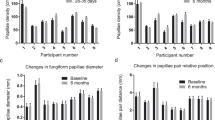Summary
Single human taste papillae in 5 young test subjects were electrically stimulated 84 times earch with a silver wire (0.4 mm tip diameter)versus a 5 × 3.5 cm2 reference electrode on the left wrist of the subject. The electrical pulses were positive (54 papillae) or negative (45 papillae) of 0.5 msec duration and had a frequency of 50, 100, 200, 400, 600 or 800 Hertz. For control 45 papillae were merely touched by the electrode without current stimulation. Significant gustatory and tactile results (χ2-test,P ≤ 0.05) signaled by the subjects were: a) on anodic stimulation 50 ± 5% of the touched papillae gave overall taste responses, namely 22.2% sour, 3.8% bitter and 1.8% salty; the rest were mixed sensations. Sweet was not reported in these final experiments; b) on cathodic stimulation 42.2 ± 5% of the papillae responded with taste, which again were reported as 22.2% sour, 2.2% salty, the rest mixed; c) on mere touching there were hardly any gustatory sensations reported.—These results indicate only a relative specifity for each single human taste papilla and its taste fibres.
Similar content being viewed by others
References
Allen, F., Weinberg, M.: The gustatory sensory reflex. Quart. J. exp. Physiol.15, 385–420 (1923)
Arvidson, K.: Scanning electron microscopy of fungiform papillae in the tongue of man and monkey. Acta Otolaryng. in press (1976)
v. Békésy, G.: Sweetness produced electrically on the tongue and its relations to taste theories. J. appl. Physiol.19, 1105–1113 (1964)
v. Békésy, G.: Duplexity theory of taste. Science145, 834–835 (1964)
v. Békésy, G.: Temperature coefficients of the electrical thresholds of taste sensations. J. gen. Physiol.49, 27–35 (1965)
Bujas, Z.: Taste provoked by continuous and iterative electrical stimulation of the tongue. Jugoslavenska Akademija Znanosti i Umjetnosti, Odjel za Prirodne Nauke Zagreb 1970, pp. 79–92
Bujas, Z.: Electrical taste. In: H. Autrum, R. Jung, W. R. Loewenstein, D. M. McKay and H. L. Teuber (edit. board) Handbook of sensory physiology, vol. IV/2, taste (L. M. Beidler, ed.), pp. 180–199. Berlin-Heidelberg-New York: Springer 1971
Bujas, Z., Chweitzer, A.: “Goût electrique” par courants alternatives chez l'home. C. R. Soc. Biol. (Paris)126 (1937) 1106–1109
Bujas, Z., Szabo, S.: The psychophysical functions relating the subjective intensity of electrically provoked taste to stimulus magnitude. Acta Instituti Psychologici Universitatis Zagrabiensis Nr. 65, 5–32 (1972)
Bujas, Z., Szabo, S.: Signal detection theory and electrical taste sensitivity. Acta Instituti Psychologici Universitatis Zagrabiensis Nr. 66, 33–43 (1972).
Dzendolet, E.: Electrical stimulation of single human taste papillae. Percept. Motor Skills14, 303–317 (1962)
Dzendolet, E.: Basis for taste quality in man. In: C. Pfaffmann, ed. Olfaction and taste, III, pp. 420–427. New York, N. Y.: Rockefeller Univ. Press 1969
Erickson, R. P.: Sensory neural patterns and gustation. In: Olfaction and taste, I. pp. 205–213. Oxford: Pergamon Press 1963
Erickson, R. P.: Duplexity theory of taste. Science147, 890 (1965)
Erickson, R. P., Doetsch, G. S., Marshall, D. A.: The gustatory neural response function. J. gen. Physiol.49, 247–263 (1965)
Frank, M.: An analysis of hamster afferent taste nerve response functions. J. gen. Physiol61, 588–618 (1973)
Frank, M.: The classification of mammalian afferent taste nerve fibres. Chem. Senses and Flavor1, 53–60 (1974)
Frank, M., Pfaffmann, C.: The distribution of taste sensitivities among single taste fibres. In: (C. Pfaffmann, ed.). Olfaction and taste, III, pp 488–491. New York: Rockefeller Univ. Press 1969
v. Frey, M.: Beiträge zur Sinnesphysiologie der Haut. III. Mitteilung. Ber. sächs. Ges. (Akad.) Wiss., Math.-phys. Classe47, 166–184 (1895)
Gertz, H.: Une expérience critique relative à la théorie du goût électrique. Acta oto-laryng. (Stockh.)1, 551–556 (1918–1919)
Heck, G. L., Erickson, R. P.: A rate theory of gustatory stimulation. Behav. Biol.8, 687–712 (1973)
Helmbrecht, J.: Über den elektrischen Geschmack: Qualitäts-und Intensitätsbeziehungen. Arch. Ohr.-, Nas.-u. Kehlk.-Heilk.192, 314–324 (1968)
Hubbard Jones, M. H., Jones, F. N.: The critical frequency of taste. Science115, 355–356 (1954)
Ichioka, M.: On some psychophysical aspects to the study of the human gustatory sensation. Proc. Int. Un. physiol. Sciences, XXV. International Congress, Munich 1971,8, pp. 56–57 (1971)
Innitzer, J., Plattig, K.-H.: Preferences of single papillae of the human tongue for certain taste qualities studied by electrical stimulation. Pflügers Arch.335, R 76 (1972)
Jauhiainen, T., K.-H. Plattig: Reizsynchrone langsame Rindenpotentiale beim Menschen nach elektrischer Reizung der Zunge. Pflügers Arch. ges. Physiol.289, R 27 (1966)
Kimura, K., Beidler, L. M.: Microelectrode study of taste receptors of rat and hamster. J. cell. comp. Physiol.58, 131–139 (1961)
Marshall, D. A.: Acomparative study of neural coding in gustation. Physiol. Behav.3, 1–15 (1968)
Pfaffmann, C.: Gustatory afferent impulses. J. cell. comp. Physiol.17, 243–258 (1941)
Pfaffmann, C.: The sensory coding of taste quality. Chem. Senses and Flavor1, 5–7 (1974a)
Pfaffmann, C.: Specifity of the sweet receptors of the squirrel monkey. Chem. Senses and Flavor1, 61–67 (1974b)
Pierrel, R.: Taste effects resulting from intermittent electrical stimulation of the tongue. J. exp. Psychol.49, 374–380 (1955)
Plattig, K.-H.: Über den elektrischen Geschmack, Reizstärkeabhängige evozierte Hirnpotentiale nach elektrischer Reizung der Zunge des Menschen. Z. Biol.116, 161–211 (1969)
Plattig, K.-H.: Taste sensations and evoked brain potentials after electric stimulation of tongue in man. In: Gustation and olfaction, pp. 73–86. G. Ohloff and A. F. Thomas, eds. London-New York: Academic Press 1971
Plattig, K.-H.: On the specifity of single human tongue papillae studied by electric stimulation. In: Olfaction and taste, IV, pp. 323–328. D. Schneider, ed. Stuttgart: Wissenschaftl. Verlags-GmbH 1972
Plattig, K.-H.: Alternation of taste quality preferences of single human tongue papillae. Pflügers Arch.355, (1975) Suppl. R 117
Plattig, K.-H., Berg, G.: Wandlung der Geschmacksempfindlichkeit bei ballastfreier Ernährung (“Astronautenkost”). Res. exp. Med.163, 163–169 (1974)
Author information
Authors and Affiliations
Additional information
Supported by the Bundesminister des Inneren der Bundesrepublik Deutschland.
Rights and permissions
About this article
Cite this article
Plattig, K.H., Innitzer, J. Taste qualities elicited by electric stimulation of single human tongue papillae. Pflugers Arch. 361, 115–120 (1976). https://doi.org/10.1007/BF00583454
Received:
Issue Date:
DOI: https://doi.org/10.1007/BF00583454




